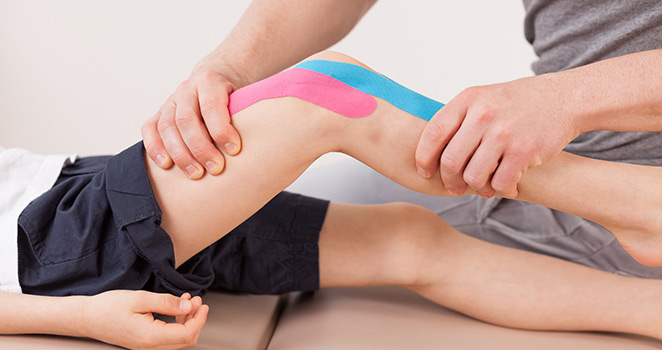Pediatric Torn Tendons & Dislocations

The medical term "tendon" refers to a certain kind of tissue fiber that, much like a rope, attaches to the bones of the human body. Tendons are designed to be both elastic and extremely strong but can be damaged for a variety of reasons, including blood type disorders, steroid use, overuse, or traumatic injury. When a tendon becomes inflamed from repetitive stress or other causes, this is known as tendonitis.
In most cases, damage to the tendons will go unnoticed or provoke only a small amount of discomfort. In more serious cases, the tearing or complete rupture of a tendon can cause agonizing pain and require medical intervention.
Although it is somewhat rare, it is also possible to dislocate the tendons, a process known medically as the subluxation of the tendon.
While tendons can be found all over the body, the exposure of certain tendons to tearing and other forms traumatic injury are generally located in one of four areas:
- Quadriceps: These tendons connect to four different muscle groups in the area just above the kneecap to the muscles of the upper leg. Sometimes referred to as just "quads", the name of the tendon connecting these muscles is the patellar tendon from the medical term for the knee (patella).
- Achilles: Named for the character in the ancient Greek legends of Homer, the Achilles tendon is located at the back of the foot and attaches the heel bone to the muscles of the calf.
- Rotator cuff: In order to allow the arm to be raised and rotated, the rotator cuff tendon connects the shoulder to four different muscle groups.
- Biceps: When the elbow is bent to lift the hand towards the shoulder, the biceps muscle is engaged. A tendon attaches the biceps both to the top of the arm as well as to the lower part of the arm.
While the above tendons can be torn, the tendons that are predominately seen in dislocation cases refer to the peroneal tendons. This term refers to tendons that connect two different muscles on the outside of the calf that connects the foot to the lower leg.
Causes of a Torn of Dislocated Tendon
Although women can both dislocated and tear their tendons, this type of injury generally affects men. Younger men usually tear the muscle that the tendon connects to before tearing the tendon but the tearing of the tendon can also occur when the muscle tears.
Most tendons become torn or dislocated due to a form of direct trauma, in other words, a strong or sharp movement of the connecting muscles or receiving a sharp blow from another object. In rare cases, tendons can be dislocated or torn due to age (and a subsequent loss of blood supply that weakens the tendon fibers) or a steroid injection into the tendon that is used to treat tendonitis.
While not comprehensive, the most common causes of tendon tears and dislocations are:
- Quadriceps: Receiving a blow to the knee or space just above the knee or twisting the knee when it is under stress.
- Achilles: Engaging in physical activity for a person who is not in shape by landing after jumping from a height, or sustaining a blow directly to the tendon.
- Rotator cuff: Sustaining a blow from an exterior source, lifting an object that is too heavy above your head, or breaking a fall from a height by using an outstretched hand.
- Biceps: Lifting a very heavy weight or twisting the upper arm.
- Peroneal: Twisting or straining the tendon, most often when (snow) skiing but it can occur when playing football, soccer, and basketball.
Symptoms of a Torn or Dislocated Tendon
While only a medical professional can diagnose a torn or dislocated tendon, some of the common symptoms include:
- Sudden onset of excruciating pain
- Hearing or feeling a "pop" or "snap
- Sudden inability to bear weight in the area
- A bulging or deformity in the affected area
- Finding that the muscle or joint is very weak
- Being unable to move the affected area at all or only a little
Some symptoms specific to each type of tendon injury include:
- Quadriceps: Inability to bear weight on the affected leg
- Achilles: Inability to stand on tiptoes
- Rotator cuff: Inability to raise the arm out to the side
- Biceps: Difficult raising the arm out to the side when the palm is turned upward.
- Peroneal: Feels like a severe ankle sprain.
If you suspect that you have torn or dislocated a tendon, seek medical advice right away.
Treatments for a Torn or Dislocated Tendon
The duration and type of treatment of a torn or dislocated tendon depend on the nature and severity of the injury. In minor cases, there may be little to no discomfort and the prescribed treatment is rest and/or the use of over-the-counter anti-inflammatory pain relievers.
For more serious cases of a torn or dislocated tendon, non-surgical treatments include a period of rest with no weight being applied to the injured area, meaning individuals with foot or leg tendon injuries must use crutches. Ice can be applied to reduce swelling and anti-inflammatory medications can be used as well. In some cases, a cast or compression bandage may need to be applied to completely immobilize the injured area.
In more severe cases, surgery may be needed to repair the tendon.